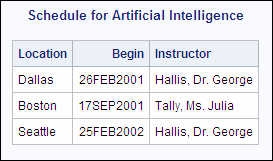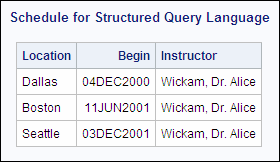Creating Multiple Macro Variables during DATA Step Execution
Creating Multiple Macro Variables with CALL SYMPUT
Sometimes you might
want to create multiple macro variables within one DATA step. For
example, suppose you want to write a program that lists all of the
scheduled dates for a particular course, using a macro variable to
record the title of the course.
%let crsid=C005; data _null_; set sasuser.courses; where course_code="&crsid"; call symput('title',trim(course_title)); run; proc print data=sasuser.schedule noobs label; where course_code="&crsid"; var location begin_date teacher; title1 "Schedule for &title"; options nodate nonumber; run;
In this example, the
value of the data set variable
Course_title for
the course whose Course_code is C005 is
assigned as a value for the macro variable title.
The value _null_ on the data statement is
used because we do not need a data set to be created in this example.
In order to create a
listing for a different course, you would need to change the %LET
statement and resubmit the DATA step to assign a new value to
title.
Then you would need to resubmit the PROC PRINT step. Although you
would need to resubmit both the DATA step and the PROC PRINT step,
these two steps would be identical to the steps that you submitted
for the first report. This is an extremely inefficient program. %let crsid=C004; data _null_; set sasuser.courses; where course_code="&crsid"; call symput('title',trim(course_title)); run; proc print data=sasuser.schedule noobs label; where course_code="&crsid"; var location begin_date teacher; title1 "Schedule for &title"; options nodate nonumber; run;
Instead of executing separate DATA steps
to update the same macro variable, you can create related macro variables
in one DATA step. To create multiple macro variables, you use the
SYMPUT routine with DATA step expressions for both arguments.
|
General form, SYMPUT
routine with DATA step expressions:
CALL SYMPUT(expression1,expression2);
expression1
evaluates to a character
value that is a valid macro variable name. This value should change
each time you want to create another macro variable.
expression2
is the value that you
want to assign to a specific macro variable.
|
Example
In this example, you
use one call to the SYMPUT routine in order to create one macro variable
for each value of the DATA step variable
Course_code and
to assign the corresponding value of Course_title to
each macro variable. That is, for each observation in Sasuser.Courses,
the macro processor creates a new macro variable. The new macro variable
has the same name as the value of the data set variable Course_code for
that observation. The value of the new macro variable is the value
of the data set variable Course_title for
that observation. data _null_;
set sasuser.courses;
call symput(course_code, trim(course_title));
run;
%put _user_;The SAS log shows that
six observations were read from the data set Sasuser.Courses and that
six global macro variables were created and were assigned values.
2 data _null_;
3 set sasuser.courses;
4 call symput(course_code, trim(course_title));
5 run;
NOTE: There were 6 observations read from the dataset
SASUSER.COURSES.
NOTE: DATA statement used:
real time 0.52 seconds
cpu time 0.13 seconds
7 %put _user_;
GLOBAL C006 Computer Aided Design
GLOBAL C001 Basic Telecommunications
GLOBAL C002 Structured Query Language
GLOBAL C003 Local Area Networks
GLOBAL C004 Database Design
GLOBAL C005 Artificial Intelligence |
You can then use these
new macro variables to print listings of information for various courses,
using only one DATA step, as follows:
data _null_; set sasuser.courses; call symput(course_code,trim(course_title)); run; %let crsid=C005; proc print data=sasuser.schedule noobs label; where course_code="&crsid"; var location begin_date teacher; title1 "Schedule for &c005"; run; %let crsid=C002; proc print data=sasuser.schedule noobs label; where course_code="&crsid"; var location begin_date teacher; title1 "Schedule for &c002"; run;
This is the output from
the first PROC PRINT step.
This is the output from
the second PROC PRINT step.
The program in this
section is more efficient than the program shown in the previous section
since the Sasuser.Courses data set is read only once in the latest
example. However, there is still room for improvement.
..................Content has been hidden....................
You can't read the all page of ebook, please click here login for view all page.


